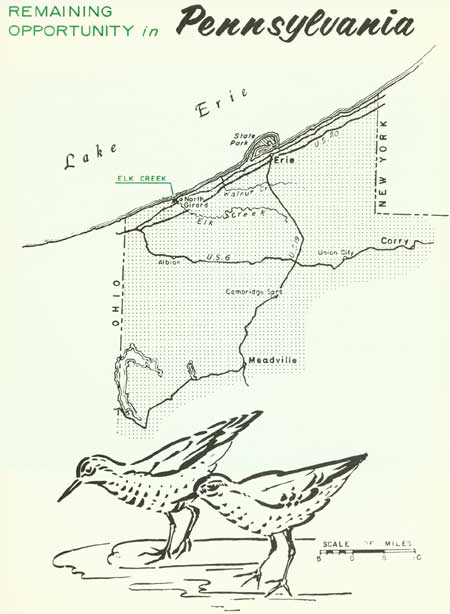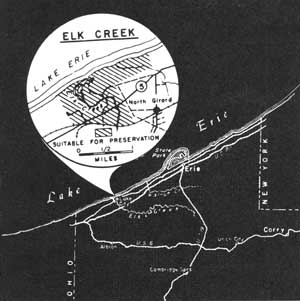|
NATIONAL PARK SERVICE
Great Lakes Shoreline Recreation Area Survey |

|
REMAINING OPPORTUNITIES IN PENNSYLVANIA

|
| Remaining Opportunities in Pennsylvania (Vicinity Map) (click on image for an enlargement in a new window) |
SUMMARY
When the State of Pennsylvania purchased the 200,000-acre Erie triangle from the Federal Government in 1778, undoubtedly there was little concern over recreation values. Probably no one considered that the great sand spit, enclosing the harbor of the future city of Erie, possessed some of the finest beaches on Lake Erie. Nor could they foresee the historic events that were to take place in that harbor in connection with Commodore Perry and the War of 1812.
Now, 181 years later, school children study those historic events, and people from as far away as Cleveland, Pittsburgh and Buffalo, know and enjoy the beaches. Today the entire peninsula forms the Presque Isle State Park. And it is a truly outstanding park, rich in history, wildlife and recreation values. The spit sweeps along the lake for 7.8 miles in a continuous beach backed by ponds, vegetated dunes, and the waters of the bay. With all this it would appear that Pennsylvania has ample recreation coverage on its 51 miles of Lake Erie shore. Yet this is not necessarily true when one considers all the factors.
The eastern end of the peninsula is closed to public access to give needed protection to a fine colony of nesting common terns and to other wildlife. The city of Erie, with a population of 134,000 people, lies adjacent to the park. This factor exerts a continuous pressure on the area throughout the season. The bay waters afford excellent opportunity for ice fishing in the winter. Finally, with the providential exception of the park, good sand beaches are practically nonexistent along the Pennsylvania shore and those of adjacent New York and Ohio. Thus, people from as far away as Pittsburgh take regular weekend jaunts to enjoy the sand, water and sun of Presque Isle State Park. All of these factors tend to funnel large numbers of people into an excellent, but limited, recreation area. To meet this demand, the Department of Forests and Waters in cooperation with the U.S. Beach Erosion Board and U.S. Army Engineers have recently completed a huge restoration project along the 7-mile beach area. A multi-million dollar park improvement program is now under way to provide much needed facilities for public recreation.
Not everyone, however, goes to Lake Erie to swim or sun bathe. Picnicking, nature study, hiking, boating, fishing, painting and simply getting away from the confines of the city are all legitimate recreation uses. Other areas along the lake that could supply these facilities would tend to alleviate the pressure on the State Park. The most likely places for such parks would be where streams cut through the high shore bluffs that line this stretch of Lake Erie. Access to the lake is possible in such instances, and beaches of sorts occur at the mouths of the streams. Boat launching sites, harbors of refuge and camping are other possibilities. These narrow valleys are usually wooded, while the lands above the bluffs are ordinarily in farmland. Such an area is the Elk Creek site described on the following page.

|
| Presque Isle State Park |
| PENNSYLVANIA |
ELK CREEK

LOCATION The study area lies in Erie County about midway between Conneaut, Ohio and Erie, Pennsylvania. It may be reached by following a road 3 miles north from Girard along Elk Creek. About 1-1/2 miles of shore frontage and 850 acres of land are involved.
DESCRIPTION Elk Creek is the largest stream flowing in to Lake Erie in Pennsylvania. Along most of its course it is swift flowing, dropping 677 feet in 25 miles through deep ravines. Near the lake it becomes a series of riffles and pools, forming a continuous pool near its mouth. The stream valley is about 100 feet deep and topped by flat land, mainly agricultural.
The stream is of interest for its fish life. In late May, numerous gar and suckers were seen, along with spiny-rayed fish. The stream may be important to spawning fish from Lake Erie, and its significance will be expanded if attempts by the State Fish Commission to establish spawning runs of rainbow trout succeed. Fishing appears to be popular near the mouth of the stream. The area has a large variety of bird life. Small mammals, amphibians and reptiles in considerable numbers also occur.
Along the stream, black willows, sycamores and ash trees grow in a park-like stand. Beneath them, a large growth of cinnamon fern adds an almost tropical touch. On the valley slopes, an attractive second growth hemlock-hardwood forest occurs with sugar maple predominating. Stumps to three feet in diameter indicate the size the trees once attained. The beach is backed by bluffs over 50 feet high. East along the shore, the area is extended to include the 80-acre community-owned park near North Girard.
PRESENT USE A small marina development occurs at the creek's mouth. Some agricultural land is included and perhaps two or three structures. The 80-acre township park mentioned above lies at the east end of the study area. Some intermittent logging probably takes place, and fishing occurs at the mouth of Elk Creek.
ANALYSIS Because of its biological diversity, the stream and surrounding lands would serve ideally as a natural area. Sport fishing would be a compatible use, and the existing community park could be expanded to accommodate camping, picnicking and possibly swimming. Under such conditions, this area would offer recreational diversity along the Lake Erie shoreline and supplement the resources of the state park at Erie.

|
| Elk Creek |
| <<< Previous | <<< Contents>>> | Next >>> |
rec_area_survey/gl/pa.htm
Last Updated: 27-Jun-2007